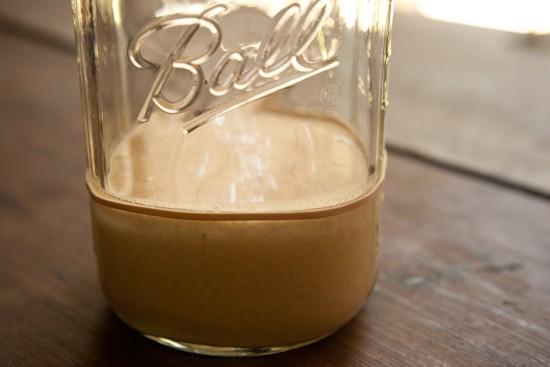
I’m back to tell you about day two of my sourdough starter experiment. So, 24 hours later and my jar of flour and pineapple juice looks exactly the same. But that’s okay, I wasn’t expecting any change yet.
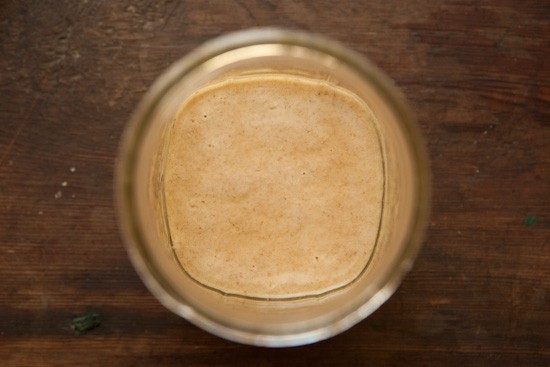
There were a few teeny tiny bubbles in the top, but I’m not sure if that’s a sign of activity or not. Either way, it’s time to feed this thing. I prefer to do this in a separate bowl so that I can clean out the jar and start fresh. It makes it easier to read the level of the starter and see if any growth occurs tomorrow. (Update: this method works great! Scroll to the very bottom of the page for printable instructions.)
I scraped the contents of my jar into a mixing bowl and added 1 cup of unbleached all-purpose flour (the type of flour has changed from yesterday) and 1/2 cup of pineapple juice.
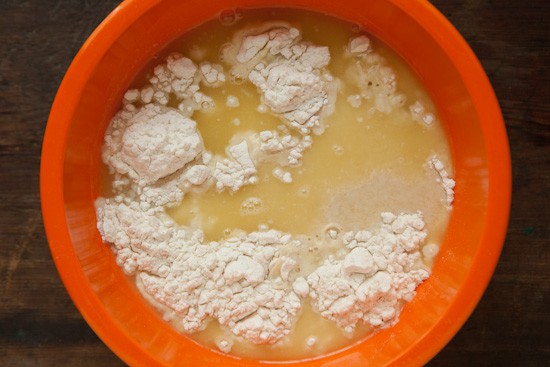
I mixed it all together until the all the flour was completely hydrated. The consistency of my starter is kind of like a pancake batter. I’ve already had some questions on Facebook about the thickness of the starter. Depending on what brand of flour you used and how you measured the flour, you may end up with a thicker dough-like consistency. That’s fine. If you prefer it to be less thick, just add a bit more liquid. It will still work – this process is pretty flexible.
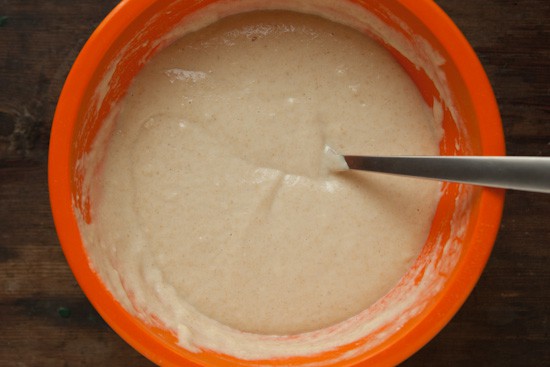
After mixing up today’s batch, I cleaned the glass jar and scraped the mixture back into the jar. I used a rubber band to mark the level of the starter and covered the top with a paper towel secured with a rubber band, just like yesterday. I’m hoping that by day three, I will notice some activity.
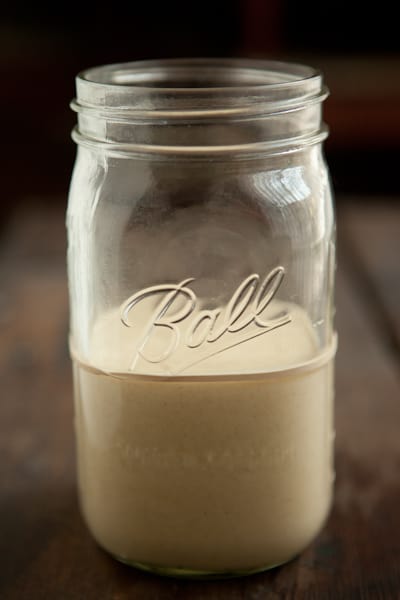
Want to create your own sourdough starter?
Here are the instructions (click on the links for photos):
Day One: In a small bowl, mix one cup of whole wheat or whole rye flour with 3/4 cup (6 oz) canned pineapple juice (at room temperature) until all of the flour is hydrated. Scrape mixture into a quart-size wide mouth glass container, such as a jar or glass measuring cup. Mark the level of the starter with a piece of tape or rubber band. Cover the container with a paper towel, cheesecloth, or coffee filter and secure with a rubber band. Leave at room temperature for 24 hours.
Day Two: You probably won’t notice much change at this point. Scrape the contents of the jar into a mixing bowl and add 1 cup of unbleached all-purpose plus 1/2 cup pineapple juice (make sure juice is room temperature). Mix until all ingredients are evenly distributed. Wash and dry your glass container and scrape the mixture into the container. Mark and cover the container just like day one. Let sit at room temperature for 24 hours.
Day Three: You may notice some activity at this point. The mixture may have risen some and there might be bubbles. Regardless of whether you notice any fermentation or not, discard half of the mixture (or give it to a friend to cultivate), and mix the remaining half with 1 cup of unbleached all-purpose and 1/2 cup filtered water (make sure water is room temperature). Wash and dry your container and scrape the mixture into the container. Mark and cover as before. Let sit at room temperature for 24 hours.
Day Four: The mixture should have at least doubled in size at this point. If it seems to be sluggish and hasn’t doubled in size, allow it to sit at room temperature for another 12 to 24 hours. Otherwise, repeat instructions for Day three.
Day Five: Feed the starter (repeating day three instructions) first thing in the morning and then again in the evening (about 12 hours apart).
Day Six: If your starter has been very active and always doubles in size (or more) between feedings, then your starter is ready to bake with. You may also choose to refrigerate your starter at this point and slow down the feedings to once a week. If you’d like to bake some bread, here is a basic sourdough bread recipe to get you started. If your starter still seems a little sluggish, continue with the twice daily feedings as above.
Day Seven: Same as above.
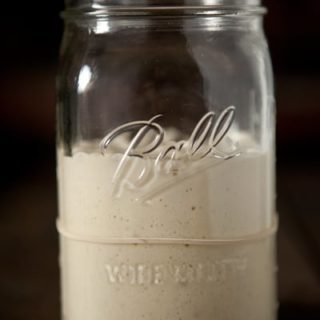
How to Make a Sourdough Starter
Ingredients
- 5-pound bag unbleached all-purpose flour
- 1 cup whole wheat flour or whole rye flour
- 1 1/4 cups pineapple juice
- filtered or bottled water*
Instructions
- Day One: In a small bowl, mix one cup of whole wheat or whole rye flour with 3/4 cup (6 oz) canned pineapple juice (at room temperature) until all of the flour is hydrated. Scrape mixture into a quart-size wide mouth glass container, such as a jar or glass measuring cup. Mark the level of the starter with a piece of tape or rubber band. Cover the container with a paper towel, cheesecloth, or coffee filter and secure with a rubber band. Leave at room temperature for 24 hours.
- Day Two: You probably won't notice much change at this point. Scrape the contents of the jar into a mixing bowl and add 1 cup of unbleached all-purpose or unbleached bread flour plus 1/2 cup pineapple juice (make sure juice is room temperature). Mix until all ingredients are evenly distributed. Wash and dry your glass container and scrape the mixture into the container. Mark and cover the container just like day one. Let sit at room temperature for 24 hours.
- Day Three: You may notice some activity at this point. The mixture may have risen some and there might be bubbles. Regardless of whether you notice any fermentation or not, discard half of the mixture (or give it to a friend to cultivate), and mix the remaining half with 1 cup of unbleached all-purpose or bread flour and 1/2 cup filtered water (make sure water is room temperature). Wash and dry your container and scrape the mixture into the container. Mark and cover as before. Let sit at room temperature for 24 hours.
- Day Four: The mixture should have at least doubled in size at this point. If it seems to be sluggish and hasn't doubled in size, allow it to sit at room temperature for another 12 to 24 hours. Otherwise, repeat instructions for Day three.
- Day Five: Feed the starter (repeating day three instructions) first thing in the morning and then again in the evening (about 12 hours apart).
- Day Six: If your starter has been very active and always doubles in size (or more) between feedings, then your starter is ready to bake with. You may also choose to refrigerate your starter at this point and slow down the feedings to once a week. If you'd like to bake some bread, here is a basic sourdough bread recipe to get you started. If your starter still seems a little sluggish, continue with the twice daily feedings as above.
- Day Seven: Same as above.
Notes
*The reason I suggest filtered or bottled water is that chlorinated water straight from the tap might make it more difficult for your starter to get going. Some people have had no trouble using filtered water, but if you're going to invest the time in creating a sourdough starter from scratch, why take any chances? I filter my tap water through a Brita water pitcher. Any cheap bottled water would be fine, too. The only thing we're trying to avoid is chlorine. If you know that your tap water is not chlorinated, feel free to use it without filtering it.
bevanne crawley says
Laura says
Nicki says
Nicole says
Nicki says
Tracy says
Tracy says
Jenn says
Nicole says
Annie says
Jenn says
Emily says
Annie says
kim says
kim says
Brian says
Nicole says
Brian says
Annie says
Courtney says
Nicole says